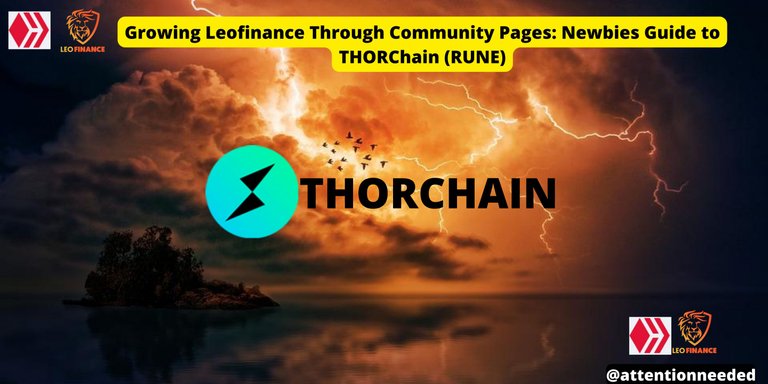According to @boscohage leofinance community needs growth more than it is and to do that he has tasked the people in the leofinance community to make quality posts talking about one of the communities in leofinance and share them on Twitter using the necessary tags to get attention from other hivers in the community and those outside the communities. Before now, truth be told I didn’t pay attention to the other 18 communities on the leofinance community and I believe others too are in this category.
The 18 community pages include:
Apeboard Finance, Defi Return, Polygon, Coin Desk
Avalanche, Coin Market Cap, Bitcoin.com, Coin Gecko
BSC, Debank, Coin Telegraph, Comdesk, Ethereum, Fantom
Shapeshift, Solana, Splinterlands, and Thorchain.
I will be talking about THORChain now.
Introduction to THORChain
THORChain is a decentralised or permissionless liquidity protocol or platform that allows one to able to swap assets within the DeFi space and it allows interoperable blockchain communication. The native token of THORChain is called RUNE and what makes THORChain unique is its effective approach to liquidity unlike other assets that are pegged on the Ethereum or Binance Smart Chain the THORChain is not.
If you are a trader or a swapper looking to swap assets on the THORChain network you can freely do so without the need you registering on the network and like I said earlier they don’t wrap their assets and if you are a liquidity provider, you can earn rewards on your assets even though they have been idle for a long period of time and you are free from lock-in periods.
Another unique feature of THORChain is that it rewards its users which contributes to the liquidity pool and the moving of assets is determined by how users act upon it. The THORChain is known as the leaderless asset vault because after accepting deposits into the vault and processing the transactions, it also makes sure they are safe from Byzantine Fault.
Byzantine Fault is a condition that a computer system usually experiences where the computer system randomly fails to process a piece of correct information due to a fault from the component and there leading to it producing wrong or imperfection information.
How it works
The THORChain uses the proof-of-stake (PoS) blockchain and it’s built on the Cosmos SDK and Tendermint (a consensus engine and a generic application interface). There are different ways in which users use the THORChain ecosystem, some use it for gaining rewards by adding liquidity to the pool, and some are just there to monitor the pools and trade (buy and sell) once in a while in order to just make profits from it and while others who just use the liquidity pools to swap their assets.
RUNE
We already know that RUNE is the native token of the THORChain protocol or network, the RUNE token helps to support as a base in order for users to be able to swap for other assets. The total maximum supply of the RUNE token is 500,000,000 and so far just 19,300 is in circulation. The key roles of the RUNE are;
- For security where they make sure the node operators are at their best.
- For governance, where the users who have the RUNE tokens can decide which asset needs more priority or attention and they vote using their RUNES
- For incentives, that is, for rewards and network fees.
Posted Using LeoFinance Beta

The rewards earned on this comment will go directly to the people( @attentionneeded ) sharing the post on Twitter as long as they are registered with @poshtoken. Sign up at https://hiveposh.com.